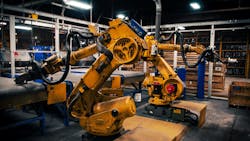Bremen Castings Inc. has placed an order for four new robotic arms to be installed in its machining operation. The Indiana gray and ductile iron foundry regularly emphasizes plant safety — recently, it passed 500 days in operation without a lost-time accident (LTA) — and the new Fanuc robots are seen as supporting the company’s safety and productivity efforts.
“Safety is our first priority,” noted BCI president J.B. Brown, “so it is essential that we protect our employees, first and foremost. This new equipment not only adds a new level of safety but it increases productivity. We are very excited to have this fully-installed in our foundry.”
The Fanuc Robotics R2000A has six axes of motion in the arm/wrist assemblage, making it an effective tool for Bremen Castings’ automated grinding processes. The Bremen, IN, foundry installed two such robots in 2011 and it indicated these devices have “significantly” improved product consistency and standard hours of operations for automatic grinding.
As such, BCI now plans to install four more robots. Once the new units are in place the plant will have three robotic cells with six Fanuc R2000A robots, and four grinders in each work cell. Operators will load castings onto belts that will deliver castings to the cells, where the finish grinding will be completed and a robot will deliver the finished item to a container for delivery.
The set-up will allow Bremen to grind heavy castings without increasing operator fatigue risk of injury. The foundry noted it is now working to outfit its product set-ups for all castings to match the specifications of the Fanuc robots, to increase efficiency, consistency and on-time delivery.
“We have an incredible staff that come to work every single day,” Brown noted, describing the recent plant-safety accomplishment, “but we’ve implemented strategies and procedures to make sure that everyone is accountable for everyone’s safety while at work.
“One example is that we require all employees to file ‘near miss’ reports,” Brown continued. “So, if there is a cable in the way or a slippery step, the employee is responsible for moving it and filing a report to inform upper management of the issue. This example is then looked at by our executive team to determine how we can possibly change things in the future to prevent a possible situation from happening.”
Lost-time hours and recordable incidents are measured according to the U.S. Dept. of Labor’s Occupational Health and Safety Administration reporting requirements. OSHA requires plants to maintain records (OSHA Recordable Incident) on a range of work-related injuries and illnesses, including: restricted work activity (RWA); lost work activity (days away from work); medical treatment beyond first aid (OSHA recordable, non-lost time); transfer to another job due to injury; loss of consciousness; and fatality related to work. Injuries that require first aid and “near misses” are not OSHA Recordable.
The last LTA at BCI happened more than a year ago, the company noted; an employee missed one full shift, but since then the foundry and machine shop have been accident-free. It indicated that now it is eyeing 1 million man-hours and two years of without LTAs as its next milestone.
About the Author
Robert Brooks
Content Director
Robert Brooks has been a business-to-business reporter, writer, editor, and columnist for more than 20 years, specializing in the primary metal and basic manufacturing industries. His work has covered a wide range of topics, including process technology, resource development, material selection, product design, workforce development, and industrial market strategies, among others.
